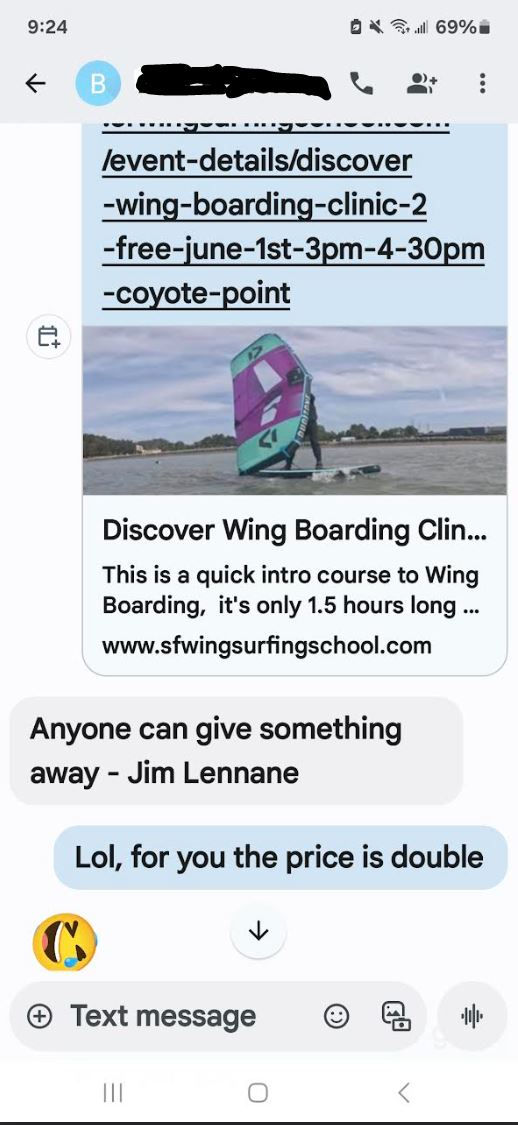Getting on Foil
- Eric Lennane
- May 7
- 3 min read
The effortless glide across the water, the hiss of the foil and wind are the only things marking your passage. The thrill of harnessing elements to dance across the water is unmatched. This is what we're all trying to capture with wing foiling.

It's also the crux of the learning process starting out. Foiling is a nuanced skill which, through practice, becomes muscle memory. Unlike other board sports, i.e., surfing, skateboarding, skiing, snowboarding, which have heavy back foot pressure where you drive the board, foiling is about attitude, board orientation, and micro adjustments. Think of flying a wing; the foil provides lift and it can stall. The angle of attack (attitude) and the speed through the water will determine the amount of lift the foil provides.
When I first learned to foil, I was on a kite and my buddy built a quick tutorial about how to use my feet to get on foil and put together sustaining "flights." Wing foiling doesn't provide the same level of power, but the approach is similar. You do a pumping motion to gain enough power to generate sufficient lift to foil. The following video illustrates the concept, and the write-up describes what is happening.

Porpoising the foil
First, make sure you have a big enough wing. As a newcomer, it's likely you will opt to go with smaller wings because they're easier to control. They are counterproductive when trying to foil because you need a lot of power to generate speed to overcome the water resistance when taxiing. Go with a wing that is typically a full meter larger than what you're used to. Power is your friend.
When you're taxiing, bear slightly off downwind, powering up the wing to generate speed. You will feel the front of the board start to rise up; resist this with your front foot and push it down, keeping the board level on the water. If needed, move up towards the nose of the board.
You may need to pump the wing to generate speed and lift.
Keep your hands high. Give 100% when pumping to reach enough power for lift-off as soon as possible. This is your ticket to ride gently on the hydrofoil. The pumping with the board must be coordinated with the power felt on the arms. The leg movement (while pumping) must allow the board to lift. Like an ollie on a skateboard – quickly switch weight to the backfoot to engage the hydrofoil and raise the front foot to allow the board to lift. Push the board back down with the front foot and repeat these steps.
As a result, the board movements will be similar to a small wave, rising up and going down and so on until reaching a constant speed on the hydrofoil. If you can create enough power to raise the board but never reach stability, it is probably due to the position of your feet. Move them a bit forward or backward to see the different results for stability.
If you pump endlessly and the board never rises, it might either be because the wing is too small and/or the wind is too light compared to your body weight and board size/hydrofoil shape. Once the board is lifted and there is enough speed, you might feel that the hydrofoil is pushing you up more. Move your front foot forward to counterbalance this. If you are powered up, you might need only one pump to raise the board.
Once hydrofoiling, make small weight adjustments to balance the hydrofoil. If the hydrofoil is lifting too much, push it back down by putting weight on the front foot. If the hydrofoil is dropping too low, put weight on the back foot to lift the board again. Ensure the hydrofoil does not touch the water surface, as this will result in a crash.
Start with smaller porpoising rides: lean slightly back, foil a few seconds, then glide back down. Increase the duration of the foil rides until you feel comfortable staying on foil. Remember to look upwind and go that direction. Once on foil, this will be easy and allows you to control the speed better.
Here are some common mistakes and fixes: Wing Foil Beginner Mistakes (review video)
Good luck, remember power is your friend when learning. Go big.
.jpg)




Comments